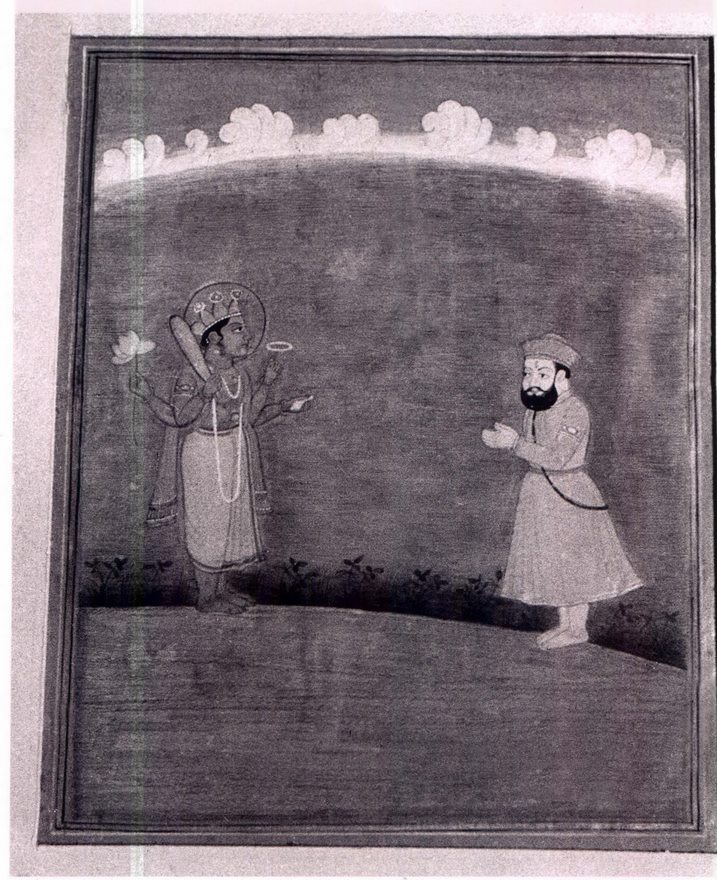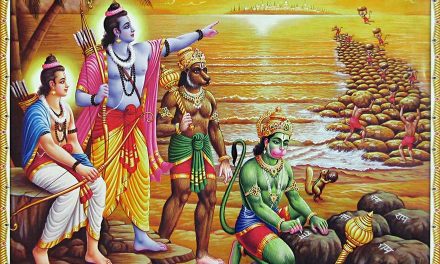In contemporary devotional pictures and posters of Guru Nanak (1469-1539), as seen in taxis and shops, the Guru is invariably shown as wearing a pagari or turban, like his pupils (Sikh-s) today. But this is a recently-imposed convention, not followed in his own day and in subsequent centuries.
In traditional paintings, the Gurus never wore turbans, a custom that even according to Sikh teaching itself was only instituted by the tenth and last Guru, Govind Singh, in 1699. All the Gurus are typically shown as wearing a topi (Hindu-style cap) and patka (sash). We discuss one instance.
K.C. Aryan (born 11 August 1919, died 2002), a Partition refugee from West Panjab, was an accomplished painter. He founded the Museum for Tribal and Folk Art in Gurgaon, still functioning today. He saved plenty of old paintings, sculptures and other arts & crafts objects for posterity by collecting them in his museum or donating them to more established institutions.
In 1970, he presented to the publishing unit of Punjabi University Patiala a manuscript with illustrations for a book, 100 Years Survey of Panjab Painting (1841-1941). It was eventually published by the PUP in 1975, but only in mutilated form. The Senate Board of the University objected to the inclusion of one particular painting, and threatened that if it were published, the grant for the whole publishing unit would be stopped.
[wp_ad_camp_1]
The contentious painting, executed by a Pahari painter in the mid-19th century (whose name, as often in folk art, remains unknown), shows a topi-wearing Guru Nanak praying to Lord Vishnu. The Board took the Sikh-separatist line that that Sikhism has nothing to do with Hinduism, and that the Gurus are above the “Brahminical” gods. It is the same line that keeps the Sikh establishment from calling their central shrine, the Hari Mandir (“Vishnu temple”), by its proper name, hiding it behind the superficial designation “Golden Temple” or the Moghul term “Darbar Sahib”. It is also why in 1922 they threw out from the Hari Mandir the murti-s that had been worshipped there ever since Arjan Dev inaugurated it in 1604. Sikh identity as a separate religion, rather than as one of the many panth-s in the Hindu commonwealth, is based on a denial of history, and this requires a constant censoring of unwilling historical data: names changed, scriptures doctored, murti-s thrown away, the publication of a painting suppressed.
K.C. Aryan donated the painting in ca. 1982 to the Himachal State Museum in Shimla. There, it is significantly not on display but kept in storage. That is, if it has not been lost or illegally sold by some babu unconcerned with art and heritage; or somehow eliminated by one with Khalistani leanings eager to destroy the evidence for an inconvenient fact: that Guru Nanak was every inch a Hindu.
Source: koenraadelst.blogspot.in














This article will be more powerful, if it didn’t have a defensive outlook. It is still written from an angle of mine-thine, while trying to be seen as dismissing the same. Of course Guru Nanak dev ji was born Hindu….there were no Sikhs back then. Were there?
In the land we know as India, there were Hindus…who diversified into Boddha, Jains, Sikhs…and a vast number into Islam (mostly y forceof clout or conversion, but there must be a certain number that embraced Islam voluntarily)
Being born a Hindu or being a Hindu? What do you mean by “he was every inch a Hindu”? He rejected Janaue at a very young age. He went against what was traditionally Hindu. Read his own version of Aarti….you will know he was beyond Hindu dogma. His poetry would tell you that he has consciously moved away from Hindu rituals and brought about a fresh outlook, expression and energy to the ritual riddled, soul less religion Hindu thought had become. ..I see your point to an extent ..Sikh-dogma. Sikhs have embraced, down the centuries. All followers are destined to be captives of their religions. A devotee is what religion should create, but that happens rarely….religions invariably creates offended and very defensive followers.
Very few get to the point where religion is all about personal relationship with divine rather than being part of a group subgroup, cult or set of rituals….and keep bickering to defend one’s own. Very shallow view of religion, which does more harm than good.
Sikh thought is a natural outcome of reformation, recycling, cleansing process that nature carries out every so often. It is a natural progression of Hinduism rather than some abrahamic philosophy, which is quite something else.
There is no denying that sikh energy is different to Hindu, but that does not mean that they don’t belong with each other. What mine-thine? I hate sikh dogma narrow ness as much Hindu or Muslim staunchness.
Religion is for people , not the other way round
Hindu or not Guru Nanak proposed the worship of a single , unique and beyond-form God.
IS IT A DISCOVERY OF FACT THAT GURU NANAK WAS A HINDU ? EVERY SIKH KNOWS IT AS EVERY BUDDHIST KNOWS IT THAT GAUTAM BUDDHA WAS A HINDU,
https://www.sikhdharma.org/sikh-history/ten-sikh-gurus/
PLEASE MAKE THE BACK GROUND OF THIS MESSAGE WHITE TO SEE LETTERS CLEARLY.HINDUISM HAS LOT OF PROBLEMS DUE TO NO PERFECT SINGLE PATH,IDOL AND WORSHIP METHOD.MORE IDOLS,WAYS, MORE PROBLEMS.
Anyone who has read and understood the message of Guru Granth Sahib ji will not bother if Guru Nanak Dev ji wore a turban or not. He was as per my elders is the biggest Ram bhakt after Lord Hanuman and Tulsidas ji. And Ram bhakts wear a turban or not, how does it matter?
I’m a Hindu and I’ve great respect for Guru Granth Sahib ji. And I know that any such article whether true or false will not enrich our minds. Hence it is a useless discovery.
Guru Nanak was HIndu we all know that infact all 10 gurus were Hindu its just that some accept it and some do not. Guru Granth is nothing but from Upanishads and Vedas though Guru Nanak ji has done predictions.
I just unsubscribed from this email list. I’ve put up with horribly written articles by people who obviously don’t speak English, but this one was too much. It’s obvious the whole purpose of this article is anti-Sikh propaganda. So there is one obscure painting that depicts Guru Nanak wearing a topi and worshiping Vishnu, and if you say anything about it you’re taking a “Sikh separatist line”? “Khalistani leanings”? This is full of biased, inflammatory language and no facts. Poor writing.
Very informative article. Many thanks to the author.
What is the big deal in this article. It is a fact that Guru Nanak ji was a Hindu. This author is trying to present it as a great discovery or a conspiracy!!!
baba nanak was born hindu but finding certain flaws as practised by pandits he preached equality,condemning some karmkand practices & wrote poetry like many other sufis inviting muslims in his embrace ,thus a new religion.BUT it does not mean drifting from ik onkar as defined in veda,upnishad,ramayan,bhagwat gita.Ram’s name is found in guru granth,hari’s too.Hindus believed in granth sahib,now too they follow sayings,marriages of hindu-sikh are very common.To protect hinduism ,one elder child of hindus became sikh,thus lot of indentification between hinduism&sikhism–an off shoot of former
Wow tq so much for highlighting this. Sikh aboviously descended frm hindus even they used to worship ma durga…and krishna and ram is glorified in their holy book by guru nanak. Dont know why they love to deny this.same like muslim uh these people.. why deny the true history be proud of ur descendent.. u cant hide anything even ur holy book tell this that it is linked with hinduism and adapt some part frm islam due to location influence. Example in malaysia
.my friends sikhs they hate being called india…what nonsense is this. Hope they still sane… lol. They wanted to be called as sikhs or punjabis. I really hate this type of attitute. Even guru nanak hv entered jagannath puri and so on… of coz he have his own theory abt god and he thought his teaching there also..bt it doesnt mean punjabis and sikhs are nt linked to indians and hinduism. Indeed they should be proud that guru nanak was a hindu descended and sikhism linked with hinduism strongly.